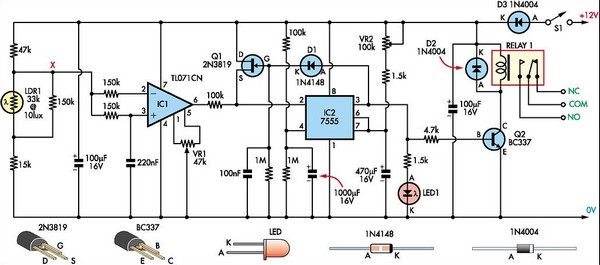Home » Circuits
Super Light Sensor
This "Super Light Sensor" responds to minute fluctuations in light level, auto-adjusting over the range from about 200 lux up to 60,000 lux (ie, from a modestly lit room to direct sunlight). It has lots of potential uses - eg, detecting a car entering a driveway, a person moving in a room, or wind rustling the leaves of a tree. At the same time, it has a high level of rejection of natural light variations, such as sunrise, sunset and the movement of clouds. While it is a "passive" system, it can also be used as an "active" system - ie, used in conjunction with a light beam.Its great advantage here is that, since it responds to fluctuations in light level rather than the crossing of a specific light threshold, it is much more flexible than other typical "active" systems. It can be placed within the line-of-sight of almost any light source, including "vague" ambient light, and simply switched on. As shown, the LDR is wired as part of a voltage divider so that, between darkness and full sunlight, its output at "X" varies between about one-quarter and three-quarters of the supply voltage. A wide variety of sensors may be used in place of the LDR, including photo-transistors, photo-diodes and infrared and ultraviolet devices.
Circuit diagram:
Fig.1: light level fluctuations are detected by LDR1 and the resulting signal fed to comparator stage IC1. IC1 in turn triggers 7555 timer IC2 which is wired as a monostable and this drives transistor Q2 and a relay.
The signal from the sensor is fed to the inputs of comparator IC1 via two 150kO resistors. However, any signal fluctuations will be slightly delayed on pin 3 compared to pin 2, due to the 220nF capacitor. As a result, the pin 6 output of the comparator (IC1) switches low during short-term signal fluctuations and this triggers monostable timer IC2. IC2 in turn switches on transistor Q2 which activates Relay 1. It also lights LED1 via a 1.5kO current-limiting resistor. Trimpot VR2 allows the monostable period to be adjusted between about 3s and 30s.
As with all such circuits, the Super Light Sensor may not work as well under AC lighting as under natural lighting. If AC lighting does prove a problem, a 16µF (16V) electrolytic capacitor can be connected between the sensor output and ground to filter the signal to the comparator. When pin 3 of IC2 goes high, FET Q1 also turns on and pulls pin 2 of IC2 high. This transistor remains on for a very short period after pin 3 goes low again due to the 100nF capacitor on its gate. This "blanking" is done to allow the circuit time to settle again after the relay disengages (and stops drawing current).
LDR placement:
Fig.2: the LDR should be installed inside a black tube, as shown here.
The "blanking" also makes it possible to run external circuits from the same power supply as the Super Light Sensor, without upsetting the circuit. The current consumption is less than 10mA on standby, so that battery operation (eg, 8 x AA batteries) is feasible. After building the circuit, switch on and wait for the circuit to settle. It's then just a matter of adjusting VR1 so that the circuit has good sensitivity without false triggering. With some experimentation, it's possible to set the circuit to change seamlessly from natural to AC lighting. If maximum sensitivity under natural lighting false triggers the circuit under AC, then adjust VR1 to give maximum sensitivity under AC (and vice versa).
In daylight, the Super Light Sensor will typically detect a single finger moving at a distance of 3m, without the use of any lenses. It will also detect a person crossing a path at a distance of more than 10m, again without lenses. And when used as an "active" system, it will typically detect a person walking in front of an ordinary light source (eg, a 60W incandescent light-bulb) at more than 10m. Note that these ranges are achieved by placing the LDR (which is used as the light sensor) in a black tube, as shown in Fig.2. A single lens will double these distances, while the use of two lenses in an "active" system will multiply the basic range by 6 or 7.
Author: Thomas Scarborough - Copyright: Silicon Chip Electronics Magazine


